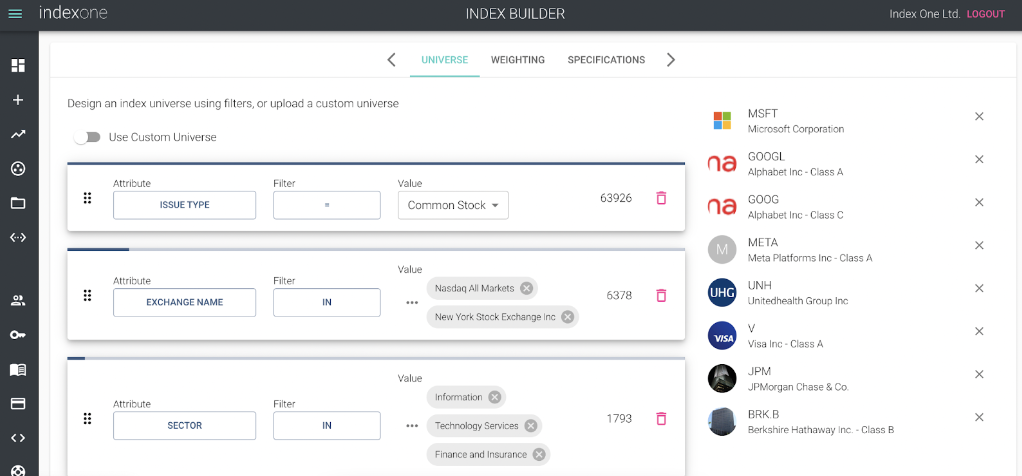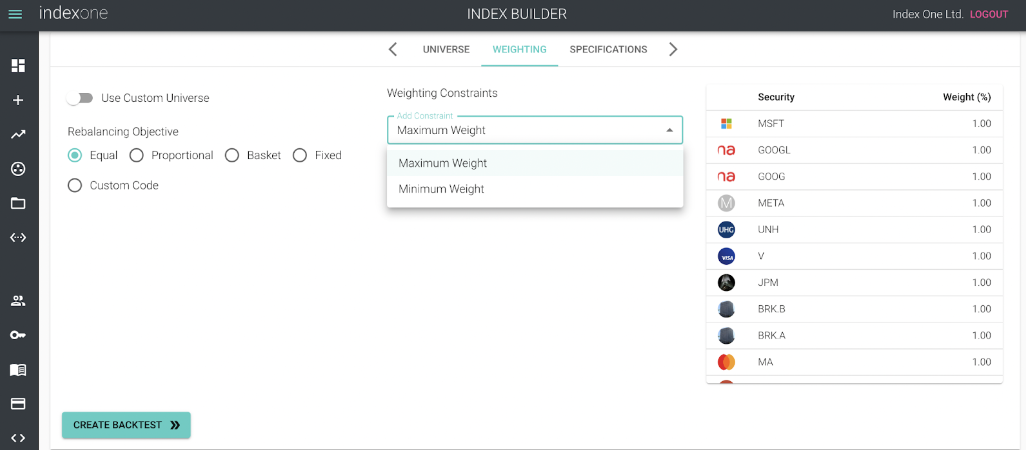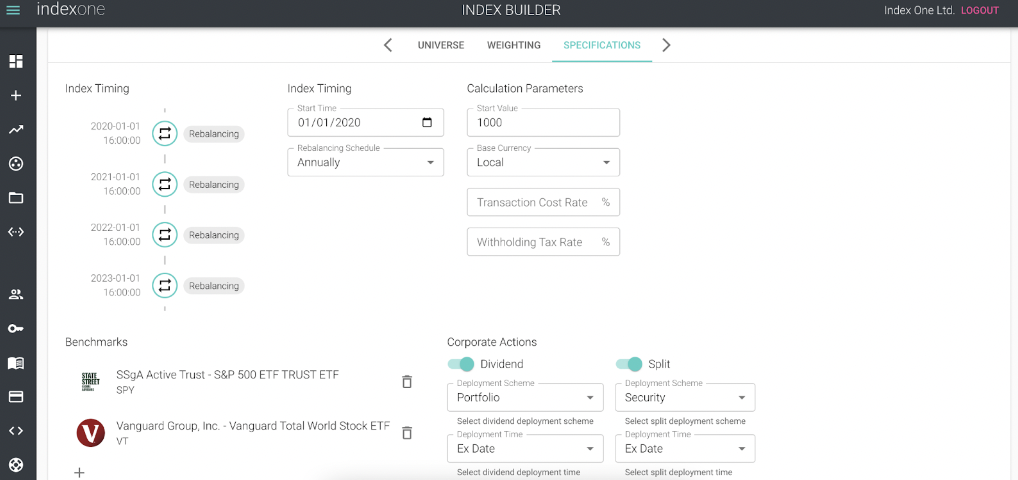ESG and Sustainable Indices
In this comprehensive guide, we'll explore the core concepts of ESG indices, sustainable investing,
custom indexing in ESG, and how to build an ESG index.
Introduction to ESG and Sustainability
Environmental, Social, and Governance (ESG) considerations have gained prominence as investors seek to align their portfolios with sustainability goals and ethical values. ESG indices and sustainable investing strategies have become key tools for those looking to make a positive impact in the world, while pursuing financial gains.
What is an ESG index?
Understanding ESG:
Environmental, Social, and Governance (ESG) factors are essential criteria for evaluating a company's sustainability and ethical practices. These factors are becoming increasingly important as investors seek to align their portfolios with socially responsible values while pursuing financial returns.
ESG Index Defined:
An ESG index, also known as a sustainability index, is a benchmark that incorporates ESG criteria into the selection and weighting of its constituent assets. Unlike traditional market benchmarks, ESG indices prioritize companies with strong ESG performance, enabling investors to focus on businesses that align with their ethical and sustainability goals.
What is sustainable investing?
Defining Sustainable Investing:
Sustainable investing is an investment approach that seeks to generate financial returns while considering the broader impact of investments on society and the environment. Sustainable investing aims to support companies and projects that promote positive change and address critical global issues, such as climate change, social inequality, and corporate ethics.
ESG Integration:
Sustainable investing involves the integration of ESG factors into investment decision-making. By incorporating ESG criteria into the investment process, investors aim to make more informed and responsible investment choices that align with their unique values and risk preferences.
Custom indexing and ESG indexs
The Role of Custom Indexing:
Custom ESG indices are designed to meet the specific goals and values of individual investors or institutions. Instead of relying on standardized ESG benchmarks, custom indexing allows investors to tailor the index construction process to align precisely with their unique ESG criteria, investment objectives, and risk tolerance.
Benefits and Challenges:
Custom ESG indexing offers several advantages, such as a higher degree of personalization and alignment with an investor's values and the ability to exclude certain industries or practices. However, it also comes with challenges, including the potential for increased data collection and analysis, the need for robust methodology, and the potential complexity of index construction.
How to build an ESG index?
List of ESG indices and sustainability investing strategies
Index One was named the winner of 2023’s ESG Insight Awards for Best ESG Index Provider. Here are some ESG indices calculated by Index One.
Frequently Asked Questions
What is index construction?
What is index construction?
Index construction refers to the process of creating and maintaining a market index, which is a hypothetical portfolio of securities that represents a specific segment of the overall market.
What is the difference between custom indexing vs direct indexing?
What is the difference between custom indexing vs direct indexing?
While direct indexing requires you to choose amongst pre-packaged solutions, custom indexing allows for unlimited customization within different factors, allowing investors to build a portfolio that truly reflects their unique investment goals and preferences.
What is the difference between active investing vs passive investing?
What is the difference between active investing vs passive investing?
While active investing strategies focus on individual securities and a more hands-on approach, passive investing strategies tend to focus on purchasing shares of index funds or ETFs in an attempt to mirror or beat the performance of market indexes.
What is the difference between securities vs stocks?
What is the difference between securities vs stocks?
A security is the ownership or debt with value. A stock is a type of security that gives the holder of the stock ownership or equity of the publicly-traded company.
A share is a unit of ownership measured by the number of shares you own, whereas a stock is a unit of equity, measured by the percentage of ownership of the company.
What is the difference between portfolio manager vs asset manager?
What is the difference between portfolio manager vs asset manager?
A portfolio manager handles investments and other financial products that make up a portfolio. An asset manager may also manage portfolios, but they mainly handle cash and assets, which a portfolio manager does not.
What is the difference between Index vs Benchmark?
What is the difference between Index vs Benchmark?
While a benchmark only serves as a standard to measure index performance against, an index is created for a variety of reasons, and one of its purposes is to act as a benchmark. In other words, a benchmark is usually always an index, but an index doesn’t necessarily have to be a benchmark.
What is the difference between reconstitution vs rebalancing?
What is the difference between reconstitution vs rebalancing?
Rebalancing is a more automated process where price and market-cap weighted indices are rebalanced automatically. Reconstitution, on the other hand, requires the manual adding and removal of securities from an index, based on whether or not these securities are meeting index criteria.
What is the difference between an index fund vs ETF
What is the difference between an index fund vs ETF
An index fund is a mutual fund which tracks an index, while an ETF is an exchange traded asset tracking the performance of an index.
Can you invest directly in an index?
Can you invest directly in an index?
An index is a hypothetical basket of stocks. In order to invest in an index, it would need to be an investable product that tracks an index. A few examples of an investable product are mutual funds and ETFs.
How does index rebalancing work?
How does index rebalancing work?
Index rebalancing refers to the process of adjusting the composition and weights of securities within an index. It is typically done periodically to maintain the index's target representation and desired characteristics. Index rebalancing helps maintain the integrity of the index and ensures that it continues to accurately reflect the targeted market segment. It allows for adjustments to account for changes in market conditions, company fundamentals, and other factors that may affect the composition and weights of the index components.
How to create a stock index?
How to create a stock index?
Creating a stock index involves several steps and considerations, including defining the index objective, selecting the index components, determining the weighting methodology, setting the initial index values, establishing the index calculation methodology, regular maintenance and rebalancing, index calculation and dissemination and index governance and oversight.
How to construct an index for research?
How to construct an index for research?
Constructing an index for research purposes involves a tailored approach to meet specific research objectives. This includes defining research objectives, selecting the relevant securities, determining inclusion and exclusion criteria, determining weighting methodology, setting the index universe, establishing index calculation methodology, data collection and management, performing backtesting and validation, documenting index construction methodology and analyzing and interpreting results.
How to create your own index?
How to create your own index?
Creating your own index requires careful consideration of various factors, including your investment objectives, the availability of data, and the resources needed to maintain and calculate the index. It may be beneficial to seek professional advice or consult with experts in index construction to ensure the integrity and accuracy of your self-created index.
How to make your own index fund?
How to make your own index fund?
Creating your own index fund involves several steps and considerations: define the investment objective, select the index components, determine the weighting methodology, set the initial fund composition, establish a rebalancing strategy, implement the fund's portfolio, track and monitor performance, consider legal and regulatory requirements, consider administration and custody, develop a distribution strategy, and comply with reporting and governance.
Commonly Used Terms
Custom indexing
Custom indexing
custom indexing is the process of setting specific parameters on the stocks you’d like to invest money in, allowing you to personalize your investments based on your individual values, goals, preferences, risk tolerance and tax positioning.
Direct indexing
Direct indexing
direct indexing is an investing strategy that involves purchasing the individual stocks within an index, maintaining the same weights in the index.
Active management
Active management
active management involves an investment manager making investment decisions by tracking the performance of an investment portfolio.
Passive management
Passive management
passive management involves a fund’s portfolio mirroring a market index, by selecting stocks to be included in a portfolio, unlike active management.
Market index
Market index
A market index is a hypothetical portfolio that contains investment holdings. The value of a market index is based on the prices of the underlying holdings.
Efficient market hypothesis
Efficient market hypothesis
EHM, or efficient market hypothesis is a theory coined by Eugene Farma, which states that active managers can beat the market only for a given period of time, as their success is simply a matter of chance. EHM suggests that long-term passive management delivers better results than asset management.
Active investing
Active investing
active investing involves the ongoing buying and selling of securities by monitoring market index.
Passive investing
Passive investing
passive investing is a long-term strategy that involves buying securities that mirrors a market index.
Thematic investing
Thematic investing
thematic investing focuses on investing in long-term or macro-level trends. Examples of thematic investment themes include water, robotics & AI, gaming & e-sports, and space exploration.
ESG investing
ESG investing
ESG investing emphasizes on investments that prioritizes optimal environmental, social and governance outcomes.
Factor investing
Factor investing
factor investing is a type of portfolio management strategy that targets quantifiable metrics or factors that can explain differences in stock returns. These factors often include value, size, volatility, momentum, and quality.
ETF
ETF
exchange traded funds, or ETFs refer to a type of investment fund that is traded on a stock exchange. An ETF usually tracks a generic market index and allows an investor to potentially lower risks and exposure, while diversifying their portfolio.
RIA
RIA
A registered investment advisor, or RIA, is an individual or firm that advises clients on investment decisions and manages their investment portfolios.
Backtesting
Backtesting
backtesting allows an investor to test an investment strategy using historical data to assess how it would have performed before earning actual returns.
Rebalancing
Rebalancing
rebalancing involves the process of realigning the weightings of assets within a portfolio, by buying or selling the assets to maintain the original or desired level of asset allocation or risk.
Systematic portfolio
Systematic portfolio
a systematic portfolio contains securities that maintains a price higher than the predetermined level by a systematic manager. A systematic portfolio strategy invovvles trading decisions based on market price trends.
Rules-based strategies
Rules-based strategies
a rules-based investment strategy follows smart investment rules and aims to deliver active returns in a cost-efficient manner.
Active returns
Active returns
an active return is the percentage difference between a benchmark and the actual return.
Index provider
Index provider
an index provider is a firm that creates, calculates and maintains market indices based on any given investment strategy.
Sustainable investing
Sustainable investing
sustainable investing is a type of investment strategy that prioritizes environmental, social and corporate governance impacts before investing in a particular company, venture or fund. It is also called ESG investing or SRI.
Investment strategy
Investment strategy
an investment strategy is a set of principles that guide an investor to make sound investment decisions based on their financial goals, values, risk tolerance and preferences.
Alpha investment strategies
Alpha investment strategies
alpha strategies are active investment strategies that choose investments that have the potential to beat the market. Alpha is also known as “excess returns” or “abnormal rate of return.”
Benchmarking
Benchmarking
benchmarking is the process of setting a standard against which the performance of an investment strategy can be measured.
Reconstitution
Reconstitution
reconstitution is the re-evaluation of a market index to ensure that an index reflects up-to-date market cap and is balanced.
Bonds
Bonds
a bond is a type of security where the issuer of a bond owes the holder of the bond a debt, and the issuer is obligated to repay the principal of the bond at the maturity date, as well as interest on the bond.
Asset allocation
Asset allocation
asset allocation is the process of dividing an investment among different types of assets, such as stocks, bonds and cash.
Quant
Quant
quant, or quantitative analysis, is the process of using mathematical and statistical methods to make investment decisions.
Index Funds
Index Funds
index funds are a type of mutual fund or exchange-traded fund (ETF) that aim to replicate the performance of a specific market index.
Mutual Funds
Mutual Funds
a mutual fund is a type of investment fund that pools money from several investors to purchase securities.
Derivatives Structured Products
Derivatives Structured Products
derivative structured products are financial instruments that combine derivatives with other underlying assets to create investment products with unique risk and return characteristics.
Hedge Funds
Hedge Funds
similar to mutual funds, a hedge fund is a type of pooled investment fund that trades in relatively liquid assets. Hedge funds primarily use portfolio construction, complex trading and risk management techniques in an attempt to improve performance.
Index Front-running
Index Front-running
traders who watch market prices know when an index fund will update its components, allowing them to front-run the trade by buying or selling the shares to get ahead of the market and gain an edge. This is not considered illegal because it rewards individuals who pay close attention to information that already exists in the market. However, SEC Rule 17(j)-1 prohibits insiders from taking advantage of their knowledge of client trades for personal gain.




